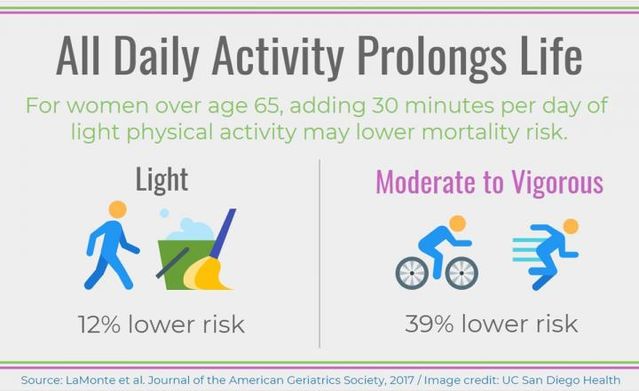Health
Light Physical Activity Prolongs Life, but MVPA Is Better
Light physical activity has huge benefits, but moderate intensity has even more.
Posted November 17, 2017
All animals (including humans) seek pleasure and avoid pain. Because most people view intense aerobic exercise as an "unpleasurable" experience, they avoid vigorous physical activity. Also, as we get older, it's more difficult to exercise with the same vigor as in our youth. Therefore, public health advocates and epidemiologists are eager to pinpoint the bare minimum prescriptive dose-response (intensity + minutes per day) of physical activity that can effectively reduce someone's risk of disease and prolong life.
The good news for people who find aerobic exercise "disagreeable" for whatever reason is that a growing body of evidence suggests that less weekly physical activity—and at an easier intensity than previously believed—can improve well-being and prolong life. That being said, moderate-to-vigorous physical activity (MVPA) still appears to have exponential life-prolonging benefits in comparison to light-intensity physical activity.
As the latest example: A new study of 6,000 women ages 63 to 99 found that just a half-hour per day of light physical activity (such as casually window shopping at the mall) reduced mortality risk by 12 percent. Notably, adding 30-minutes per day of MVPA in the form of a brisk walk or leisurely bike ride lowered mortality risk threefold, by 39 percent. These findings were published online, Nov. 16, 2017, in the Journal of the American Geriatrics Society.
In the study abstract, the authors conclude: "When measured using accelerometers, light-intensity and MVPA are associated with lower mortality in older women. These findings suggest that replacing sedentary time with light-intensity physical activity is a public health strategy that could benefit an aging society and warrants further investigation."

In a statement, Andrea LaCroix, senior author of the study and professor in the Department of Family Medicine & Public Health and chief of the Division of Epidemiology at UC San Diego, said:
"Every movement counts. Improving levels of physical activity both light and moderate could be almost as effective as rigorous regular exercise at preventing a major chronic disease. We don't have to be running marathons to stay healthy. The paradigm needs to shift when we think about being active. Older people expend more energy doing the same kinds of activities they did when younger, so their daily movement has to accommodate for this. Think of it as taking a pill (activity level) at different doses (amounts of time) depending on the age of the patient. It's not one size fits all."
Both the World Health Organization's Physical Activity Guidelines and the ODPHP Physical Activity Guidelines for Americans recommend 150 minutes per week of moderate-intensity physical activity or 75 minutes per week of vigorous-intensity physical activity (or a combination of the two) plus muscle-strengthening exercises at least twice a week.
Although there is a growing consensus among epidemiologists that brisk walking as a form of MVPA is associated with increased longevity, less than 150 minutes of moderate-intensity activity per week appears to have significant benefits.
For example, a prospective cohort study of almost 140,000 older U.S. adults, published Oct. 19, 2017, in the American Journal of Preventive Medicine found that moderate-to-vigorous physical activity (in the form of walking-based exercises) for less than the currently recommended guideline of 150 minutes per week was enough aerobic exercise to significantly improve public health outcomes and lower mortality risk when compared to inactivity. That said, the researchers also concluded that walking at or above physical activity recommendations of 150 minutes per week was associated with an even lower risk of mortality.
As another example, on Nov. 6, 2017, researchers from the Harvard University School of Public Health reported in the journal Circulation that moderate-to-vigorous physical activity (MVPA) such as brisk walking was associated a significantly lower risk of death among older women. This research involved analysis of accelerometer data from 16,741 participants (average age 72). The Harvard epidemiologists led by I-Min Lee concluded that MVPA was associated with roughly a 60 to 70 percent lower risk of death among the most active women, compared to mortality rates of the least active women during the four-year study.
From a public health perspective, Andrea LaCroix sums up the clarion call of this growing body of evidence on the dose-response of various intensities of physical activity: "With the increasing baby boomer population in the United States, it is imperative that future health guidelines recommend light physical activity in addition to more strenuous activity. When we get up from the couch and chair and move around, we are making good choices and contributing to our health."
References
LaMonte, Michael J., David M. Buchner, Eileen Rillamas-Sun, Chongzhi Di, Kelley R. Evenson, John Bellettiere, Cora E. Lewis, I-Min Lee, Lesly F. Tinker, Rebecca Seguin, Oleg Zaslovsky, Charles B. Eaton, Marcia L. Stefanick, Andrea Z. LaCroix. "Accelerometer-Measured Physical Activity and Mortality in Women Aged 63 to 99." Journal of the American Geriatrics Society (First published online: November 16, 2017) DOI: 10.1111/jgs.15201
Lee, I-Min, Eric J. Shiroma, Kelly R. Evenson, Masamitsu Kamada, Andrea Z. LaCroix, Julie E. Buring. "Accelerometer-Measured Physical Activity and Sedentary Behavior in Relation to All-Cause Mortality: The Women's Health Study." Circulation (Originally published: November 6, 2017) DOI: 10.1161/circulationaha.117.031300
Patel, Alpa V., Janet S. Hildebrand, Corinne R. Leach, Peter T. Campbell, Colleen Doyle, Kerem Shuval, Ying Wang, Susan M. Gapstur. "Walking in Relation to Mortality in a Large Prospective Cohort of Older U.S. Adults." American Journal of Preventive Medicine (First published online: October 19, 2017) DOI: 10.1016/j.amepre.2017.08.019
Stamatakis, Emmanuel, I-Min Lee, Jason Bennie, Jonathan Freeston, Mark Hamer, Gary O'Donovan, Ding Ding, Adrian Bauman, Yorgi Mavros. "Does strength promoting exercise confer unique health benefits? A pooled analysis of eleven population cohorts with all-cause, cancer, and cardiovascular mortality endpoints." American Journal of Epidemiology (Published: October 31, 2017) DOI: 10.1093/aje/kwx345


